The Hypersomnia Treatment Market is estimated to be valued at USD 3.6 billion in 2025 and is projected to reach USD 5.2 billion by 2035, registering a compound annual growth rate (CAGR) of 3.7% over the forecast period.
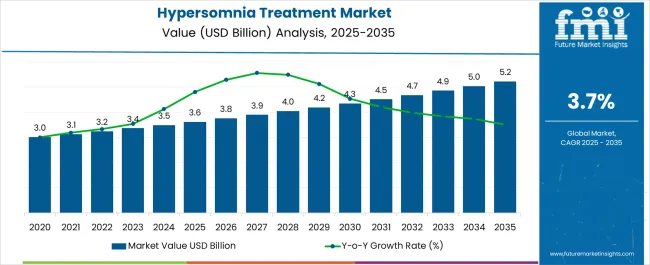
| Metric | Value |
|---|---|
| Hypersomnia Treatment Market Estimated Value in (2025 E) | USD 3.6 billion |
| Hypersomnia Treatment Market Forecast Value in (2035 F) | USD 5.2 billion |
| Forecast CAGR (2025 to 2035) | 3.7% |
The Hypersomnia Treatment market is witnessing steady growth due to the increasing prevalence of sleep disorders and heightened awareness regarding effective therapeutic interventions. Current market dynamics are shaped by the rising incidence of narcolepsy and other hypersomnia subtypes, along with growing recognition of the impact of excessive daytime sleepiness on overall health and productivity. Investments in healthcare infrastructure and advancements in pharmacological therapies are further supporting the expansion of the market.
Increasing focus on patient-centric care, early diagnosis, and management of sleep disorders is driving adoption across both developed and emerging regions. The availability of specialized healthcare services and improvements in treatment accessibility are enabling patients to receive timely interventions.
Moreover, ongoing research into novel treatment modalities and the development of targeted drugs are expected to expand the therapeutic options in the coming years As healthcare providers continue to prioritize effective management of hypersomnia and related disorders, the market is anticipated to sustain consistent growth, with new distribution models and optimized treatment strategies enhancing patient outcomes and driving future demand.
The hypersomnia treatment market is segmented by type, treatment type, distribution channel, and geographic regions. By type, hypersomnia treatment market is divided into Narcolepsey-1, Narcolepsey-2, and Idiopathic Hypersomnia. In terms of treatment type, hypersomnia treatment market is classified into Stimulants, Anti-Depressants, and Sodium Oxybate. Based on distribution channel, hypersomnia treatment market is segmented into Hospitals Pharmacies, Retail Stores, Drug Stores, and E-Commerce. Regionally, the hypersomnia treatment industry is classified into North America, Latin America, Western Europe, Eastern Europe, Balkan & Baltic Countries, Russia & Belarus, Central Asia, East Asia, South Asia & Pacific, and the Middle East & Africa.
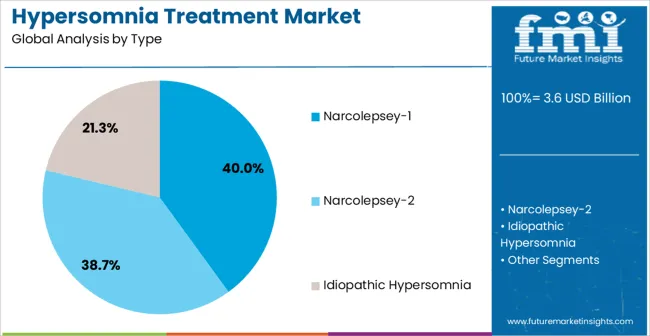
The Narcolepsy-1 type is projected to account for 40.0% of the Hypersomnia Treatment market revenue share in 2025, establishing it as the leading type segment. This dominance is attributed to the high prevalence of Narcolepsy-1 and the clinical necessity for targeted therapeutic interventions to manage excessive daytime sleepiness and cataplexy episodes. Adoption has been driven by the availability of effective pharmacological options and patient preference for structured treatment regimens that mitigate symptoms consistently.
The segment has benefitted from increased physician awareness, improved diagnostic capabilities, and expanding patient education programs emphasizing disease recognition and management. Additionally, healthcare providers have focused on individualized therapy plans, which further support the widespread use of treatments for Narcolepsy-1.
Growth is also being reinforced by ongoing clinical research that validates long-term efficacy and safety profiles of current treatments, encouraging broader adoption As awareness of the disorder rises and healthcare accessibility improves, Narcolepsy-1 treatments are expected to retain their leading position in the market.
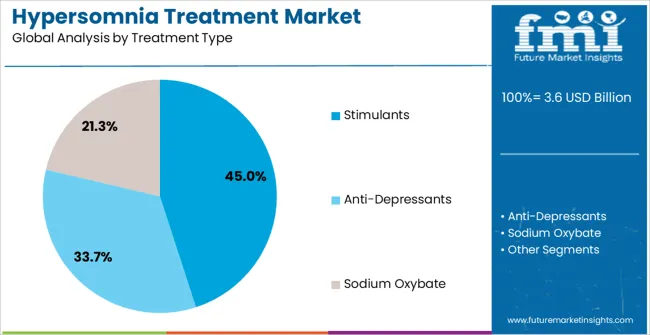
The Stimulants treatment type is anticipated to hold 45.0% of the Hypersomnia Treatment market revenue share in 2025, making it the dominant therapeutic approach. This leadership is being attributed to the effectiveness of stimulants in alleviating excessive daytime sleepiness, improving patient alertness, and enhancing quality of life.
Stimulant therapies are preferred due to their rapid onset of action and well-established clinical track record, which allows healthcare providers to address hypersomnia symptoms efficiently. The segment has been supported by rising awareness of the need for symptom control in both mild and severe cases, alongside increased adoption in both clinical and outpatient settings.
Safety monitoring and dosage optimization strategies have further facilitated the use of stimulants, reinforcing physician confidence and patient compliance As ongoing research continues to optimize formulations and explore novel delivery mechanisms, the stimulants segment is expected to maintain its market leadership, driven by continued demand for therapies that provide reliable symptom management and improve daily functioning.
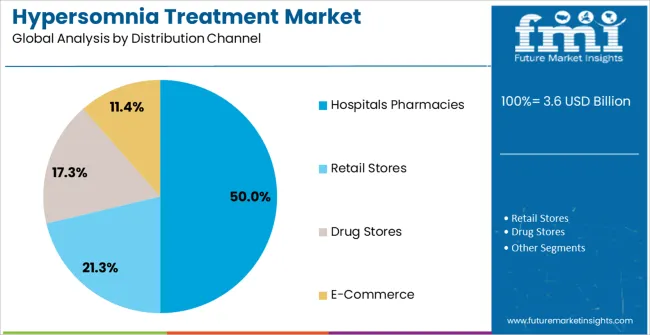
The Hospitals Pharmacies distribution channel is projected to capture 50.0% of the Hypersomnia Treatment market revenue share in 2025, establishing it as the leading channel. Growth is being driven by the central role of hospitals and pharmacies in providing patient access to prescribed treatments, ensuring proper guidance and adherence to therapy regimens.
Hospitals offer structured patient support and monitoring, which is particularly important for medications such as stimulants that require careful dosage management. Pharmacies provide wide availability and convenience for patients, supporting continuity of care and timely refills.
The dominance of this distribution channel is further reinforced by healthcare infrastructure improvements, increased physician prescriptions, and the integration of patient counseling services that enhance treatment outcomes As healthcare systems continue to expand and prioritize comprehensive management of hypersomnia, the hospitals and pharmacies channel is expected to remain the preferred route for therapy distribution, sustaining its market leadership through consistent accessibility, patient engagement, and clinical oversight.
Hypersomnia indicates frequent and excessive daytime sleepiness. It becomes necessary for patients suffering from hypersomnia to take short naps in-between the day time and sleep more than 10 hours at night. However, the naps do not provide any relief. Also, patients may feel disoriented and can have difficulty in moving. Due to hypersomnia patients may have restlessness, loss of appetite hallucinations and slow speech.
Hypersomnia is diagnosed with various tests such as by maintaining a sleep diary, multiple sleep latency test, and polysomnogram. The patients have to stay at the sleep center and the device monitors various activities during the sleep cycle of the patient.
Patients suffering from Hypersomnia and undergoing hypersomnia treatment are advised to eat high- nutrition diet. The disease cannot be prevented however its risk can be reduced by building constant sleeping environment. Hypersomnia is caused due to the withdrawal of medicines or due to head injuries and traumas.
Hypersomnia treatment help patients to remain productive during the day and the medicines help them remain awake. The medicines used during Hypersomnia Treatment activate the central nervous system which further increases alertness of the patient.
The therapeutics Provigil (Modafinil) and Xyrem (sodium oxybate) used for hypersomnia treatment provide relief for symptoms and are the two most popular branded drugs among others. The Hypersomnia Treatment would improve the quality of life of the patients.
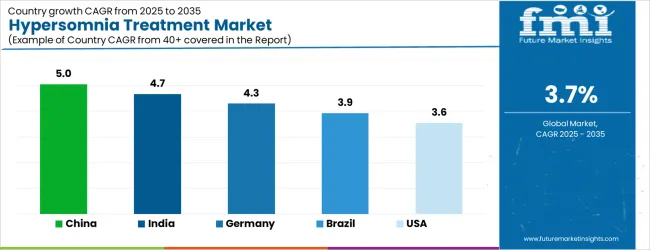
| Country | CAGR |
|---|---|
| China | 5.0% |
| India | 4.7% |
| Germany | 4.3% |
| Brazil | 3.9% |
| USA | 3.6% |
| UK | 3.2% |
| Japan | 2.8% |
The Hypersomnia Treatment Market is expected to register a CAGR of 3.7% during the forecast period, exhibiting varied country level momentum. China leads with the highest CAGR of 5.0%, followed by India at 4.7%. Developed markets such as Germany, France, and the UK continue to expand steadily, while the USA is likely to grow at consistent rates. Japan posts the lowest CAGR at 2.8%, yet still underscores a broadly positive trajectory for the global Hypersomnia Treatment Market. In 2024, Germany held a dominant revenue in the Western Europe market and is expected to grow with a CAGR of 4.3%. The USA Hypersomnia Treatment Market is estimated to be valued at USD 1.3 billion in 2025 and is anticipated to reach a valuation of USD 1.3 billion by 2035. Sales are projected to rise at a CAGR of 0.0% over the forecast period between 2025 and 2035. While Japan and South Korea markets are estimated to be valued at USD 193.7 million and USD 108.4 million respectively in 2025.
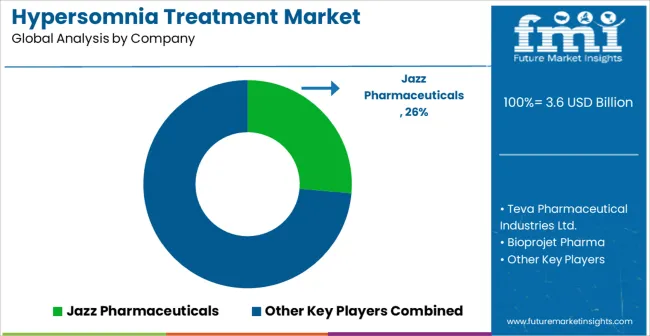
| Item | Value |
|---|---|
| Quantitative Units | USD 3.6 Billion |
| Type | Narcolepsey-1, Narcolepsey-2, and Idiopathic Hypersomnia |
| Treatment Type | Stimulants, Anti-Depressants, and Sodium Oxybate |
| Distribution Channel | Hospitals Pharmacies, Retail Stores, Drug Stores, and E-Commerce |
| Regions Covered | North America, Europe, Asia-Pacific, Latin America, Middle East & Africa |
| Country Covered | United States, Canada, Germany, France, United Kingdom, China, Japan, India, Brazil, South Africa |
| Key Companies Profiled | Jazz Pharmaceuticals, Teva Pharmaceutical Industries Ltd., Bioprojet Pharma, Novartis AG, Theranexus, Takeda Pharmaceutical Company Limited, Avadel Pharmaceuticals, GlaxoSmithKline plc, Pfizer Inc., and Merck & Co., Inc. |
The global hypersomnia treatment market is estimated to be valued at USD 3.6 billion in 2025.
The market size for the hypersomnia treatment market is projected to reach USD 5.2 billion by 2035.
The hypersomnia treatment market is expected to grow at a 3.7% CAGR between 2025 and 2035.
The key product types in hypersomnia treatment market are narcolepsey-1, narcolepsey-2 and idiopathic hypersomnia.
In terms of treatment type, stimulants segment to command 45.0% share in the hypersomnia treatment market in 2025.
Explore Similar Insights

Thank you!
You will receive an email from our Business Development Manager. Please be sure to check your SPAM/JUNK folder too.
Chat With
MaRIA